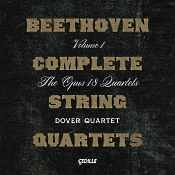By John J. Puccio
Between the years 1797 and 1826 German composer and pianist Ludwig van Beethoven (1770-1827) wrote sixteen numbered string quartets and one, single-movement, unnumbered quartet. The first six of these quartets comprise Op. 18, which we have here in the Dover Quartet’s first volume of complete Beethoven string quartets.
For those of you unsure of who The Dover Quartet are (or for those who cannot remember the information I provided in a previous review of their Mozart album, “Tribute”), they are, according to Wikipedia, “an American string quartet. It was formed at the Curtis Institute of Music in 2008 by graduates of the Curtis Institute of Music and the Rice University Shepherd School of Music. Its name is taken from the piece “Dover Beach” by Samuel Barber. The quartet consists of violinists Joel Link and Bryan Lee, violist Milena Pajaro-Van de Stadt, and cellist Camden Shaw. In 2020, the quartet was appointed to the faculty of the Curtis Institute of Music as ensemble-in-residence. Additionally, they hold residencies with the Kennedy Center, Bienen School of Music at Northwestern University, Artosphere, the Amelia Island Chamber Music Festival, and Peoples’ Symphony Concerts in New York.” The current Beethoven album is the fourth one they have released on which they are the primary performers.
So, here they give us Beethoven’s first six string quartets, written between 1798-1800, starting with No. 1, which in reality is the second quartet he wrote, but you know how those early numbering systems went with publication dates and all. Anyway, the composer admitted that he liked this second quartet better than the first ones he wrote (officially numbered as Nos. 2 and 3) because he admitted “only now have I learnt to write quartets.” OK, so No. 1 is the second one he wrote, and apparently he felt he had finally gotten it right.
Whatever, the Dover Quartet play No. 1 with elegance and élan. They do not attempt tempos quite so fast as most historically informed groups might take, yet the music is always lively and alert. The outer movements are joyous, and the slow movement is serene in a melancholy way. They mesh well. As I’ve said before, the Dover Quartet play with a passionate clarity, and while every instrument is distinctively individual, they blend perfectly as a whole.
With Nos. 4-6 (also published differently than their chronological composition dates) Beethoven really came more into his own, with No. 6 an especially strong entry with even more lyrical activity and more gravitas than the previous ones, beginning with a delightful Mozartian lilt. The last time I reviewed these Beethoven quartets was about a year or so earlier, they were done by the Eybler Quartet on the CORO label, and they did them a little differently. The Eybler Quartet are a period-instrument group and adopt a slightly faster and more flexible tempo according to historical practice. The Dover Quartet on modern instruments are marginally smoother and more mellifluous than the Eyblers and a tad more romantic in style. I welcome both perspectives and found them both a delight.
Producer Alan Bise and engineer Bruce Egre recorded the quartets at Sauder Concert Hall, Goshen College Music Center, Goshen, Indiana in 2018 and 2019. As with most Cedille recordings, this one is completely natural and lifelike, meaning it is smooth, detailed, and realistically presented. The acoustic of the hall provides a soft, ambient glow to the music that complements it nicely. Never is the sonic picture hard, bright, or edgy. Nor is it blurred, distant, spongy, or dull. It’s all quite pleasantly listenable. If I have any minor concern at all, it would be about imaging. The group seems rather widely spread out across the speakers, and there isn’t a lot of air, distance, or depth among them. It’s a common practice in miking small string ensembles, giving the impression of a single, larger group on a one-dimensional plane. Nothing of consequence, though, really.
JJP
To listen to a brief excerpt from this album, click below:










No comments:
Post a Comment
Thank you for your comment. It will be published after review.